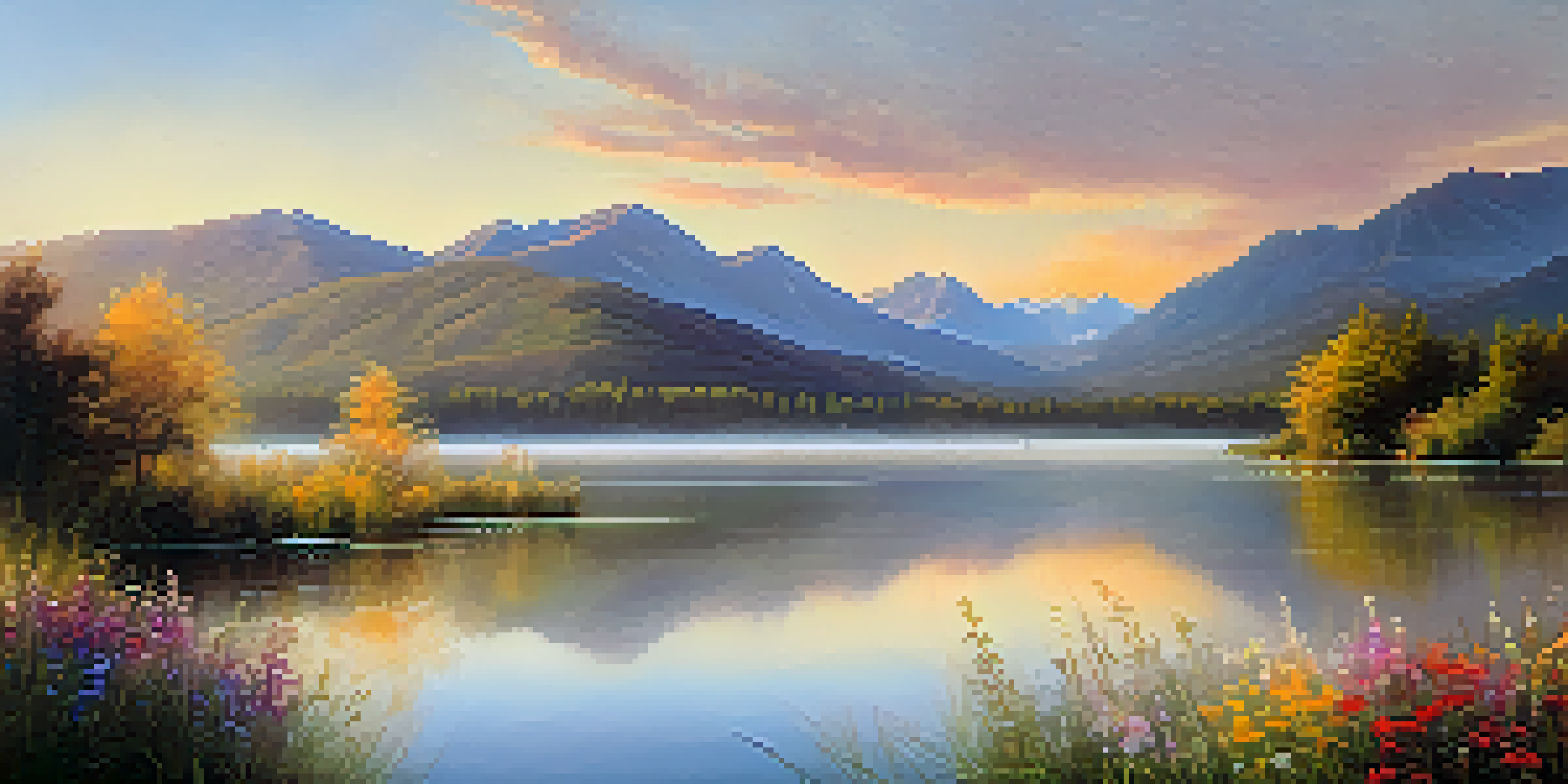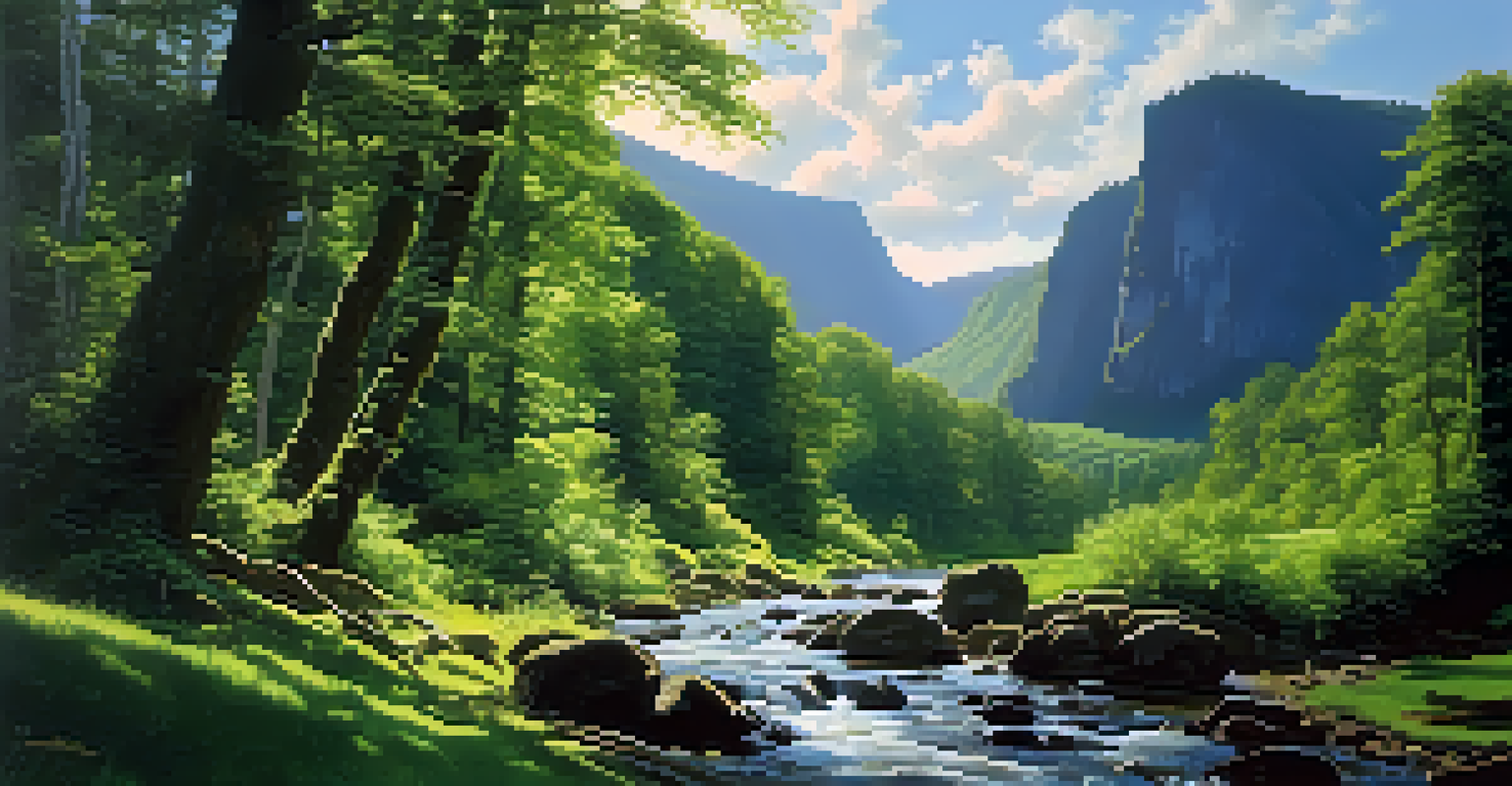Photography in Nature: Capturing Stunning Landscapes

Understanding the Basics of Landscape Photography
Landscape photography is all about capturing the beauty of the natural world. It involves more than just pointing your camera at a pretty view; it requires an understanding of composition, lighting, and perspective. By grasping these basics, you can create images that evoke emotion and tell a story.
Photography is the story I fail to put into words.
Consider the rule of thirds, for example. This technique involves dividing your frame into a grid and placing points of interest along the lines or at their intersections. This simple adjustment can enhance the visual appeal of your photographs, making them more engaging.
Additionally, understanding how light affects your subject is crucial. The golden hour, just after sunrise and before sunset, offers soft, diffused light that can transform an ordinary scene into something magical.
Choosing the Right Equipment for Nature Photography
Selecting the right gear can make a significant difference in the quality of your landscape photos. While many people believe that high-end cameras are essential, it’s often more about how you use what you have. A sturdy tripod, for instance, can help you capture sharp images, especially in low light.

Lenses also play a vital role. Wide-angle lenses are popular for capturing expansive landscapes, while telephoto lenses can help you focus on distant details. Understanding the strengths of various lenses allows you to choose the best one for your desired shot.
Master the Basics of Composition
Understanding composition techniques, like the rule of thirds and leading lines, is essential for creating engaging landscape photographs.
Lastly, don’t forget about filters. Polarizing filters can reduce glare and enhance colors, while neutral density filters help manage exposure in bright conditions. These tools can elevate your photography without breaking the bank.
Planning Your Outdoor Photography Adventure
Successful landscape photography often begins with thorough planning. Research your location to find the best spots and consider the time of year, as seasons can dramatically change the scenery. Websites and apps like PhotoPills can help you visualize how light will interact with the landscape at different times of day.
The best thing about a picture is that it never changes, even when the people in it do.
Weather conditions are another crucial factor. Overcast days can provide even lighting, while dramatic skies can add interest to your photographs. Always check the forecast and be prepared for changing conditions.
Lastly, think about the time you’ll spend on location. Arriving early or staying late can yield stunning results, as the softer light during these times can enhance the colors and textures of the landscape.
Mastering Composition Techniques for Stunning Shots
Composition is the backbone of any great photograph. Using techniques like leading lines can draw the viewer's eye into the scene, creating a sense of depth. For example, a winding path or a river can guide the viewer’s gaze toward the horizon.
Foreground interest can also add layers to your images. Including elements like rocks or flowers in the foreground helps create a sense of scale and enhances the overall composition. It encourages viewers to feel as though they are stepping into the scene.
Plan Your Photography Adventure
Thorough planning, including researching locations and considering weather conditions, can significantly enhance your landscape photography experience.
Finally, don't shy away from experimenting with angles. Sometimes, shooting from a low perspective can yield surprising results, capturing unique aspects of the landscape that are often overlooked.
Utilizing Natural Lighting for Best Results
Natural light can be your best friend in landscape photography. The quality of light changes throughout the day, and understanding how to take advantage of these variations can elevate your work. For instance, the warm, soft light of the golden hour can create a magical atmosphere in your images.
Midday sun, while often viewed as harsh, can also be utilized creatively. Experimenting with shadows and contrasts can lead to striking photographs that highlight textures in the landscape.
Always be mindful of how the light interacts with your subject. Adjusting your position or time of shooting can drastically change the mood and feel of the image.
Post-Processing: Enhancing Your Landscape Photos
Post-processing is an essential part of modern photography, allowing you to refine your images and bring your vision to life. Software like Adobe Lightroom and Photoshop can help you adjust exposure, contrast, and colors, creating a polished final product.
When editing, aim to enhance the natural beauty of your landscapes rather than over-process them. Subtle adjustments often yield the best results, ensuring your images remain true to the scene you captured.
Post-Processing Enhances Images
Utilizing post-processing tools thoughtfully allows you to refine your landscape photos while maintaining their natural beauty.
Remember, each photograph is a reflection of your unique perspective. Use post-processing as a tool to express your artistic vision and make your landscapes stand out.
Sharing Your Nature Photography with the World
Once you've captured stunning landscapes, it’s time to share your work. Social media platforms like Instagram and photography forums can be great places to showcase your images and connect with like-minded individuals. Engaging with others in the photography community can provide valuable feedback and inspiration.
Consider creating a portfolio website to display your best work professionally. This not only helps you establish your brand as a photographer but also opens doors to potential clients or collaborations.

Lastly, don’t forget to participate in local photography contests or exhibitions. These opportunities can provide exposure and help you gain recognition in the field.